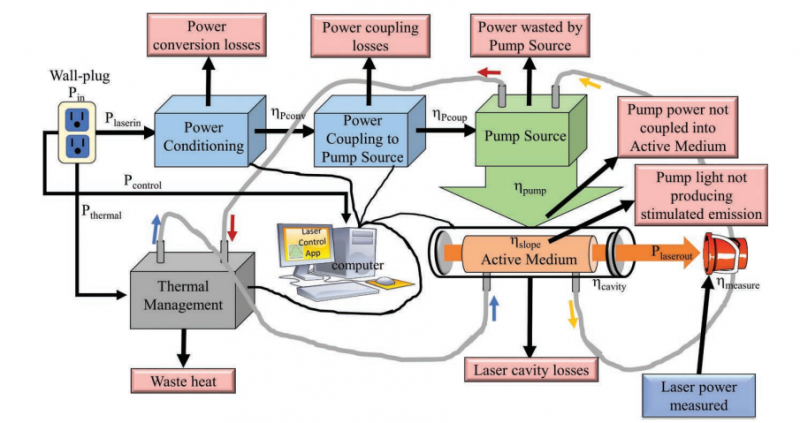What is Wall-Plug Efficiency for Laser
All lasers need a power source. They must get power from either a stored system such as batteries, an electrical outlet in the wall, solar panels, maybe a generator that runs off gas, or even from stored energy in nuclear or chemical systems. The point is lasers need power.
A very common parameter discussed by the laser scientist or engineer is the efficiency of the laser. There are many types of efficiencies to discuss when it comes to a laser and this topic is often confusing or at the very least obfuscated. In order to hopefully avoid confusion, we will start our discussion from where the power is first supplied—the wall-plug. Consider the laser system diagram shown in Figure below. The wall-plug efficiency, η wallplug, is the ratio

If a laser produces an average output power of 1mW and requires 100mW to operate then the wall-plug efficiency is 0.01% or 1%. Actual wall-plug efficiencies for lasers can range from single digit up to about 20% or so depending on the laser system. Some systems of diode-pumped solid-state lasers report upwards to 30% wall-plug efficiency but there are often questions of the calculations and if some things such as losses in the power supplies were left out. We will follow the philosophy herein that calculating or measuring from the wall-plug to operate the laser.
While it might seem difficult to understand all the losses of a system, it is possible to measure the voltage level and current draw (and therefore the power) needed to power all the systems connected to the laser as shown in Figure below. We can start tracking the power, and therefore begin looking deeper into the losses in the system, by realizing that the laser system consists of three major subsystems:
(1) the laser assembly subsystem,
(2) the thermal management subsystem, and
(3) the control subsystem. We can break

Equation down into these subsystems as

The thermal management subsystem is used to cool the laser-active medium, optics, and the pump source. Oftentimes, flashlamp-pumped lasers require a flowing liquid coolant (such as chilled water) and some other lasers require even more exotic thermal management. The power requirements for this subsystem typically involve connecting chillers, pumps, and temperature control circuits to wall-plug power. A power meter can be used to measure the actual usage, but calculations can be performed based on the thermodynamics of the specific laser system to reach a fairly accurate answer. Thermal analysis will be required for any laser scientist or engineer designing a laser system for specific applications. For example, if an assembly-line laser welder outputs 10kW of laser power continuously and has a wall-plug efficiency of 10% efficient, this suggests that there is a power need of 100kW from the wall-plug. This means the system wastes 90kW somewhere and that power will become heat that must be dealt with in some fashion.
The control subsystem typically consists of computers, sensors, control circuits, and input consoles. These components are usually straightforward and can be accounted for typically from the data supplied from the vendor about each. An example of such a component is a computer, which will have power consumption information printed on the back of it.
